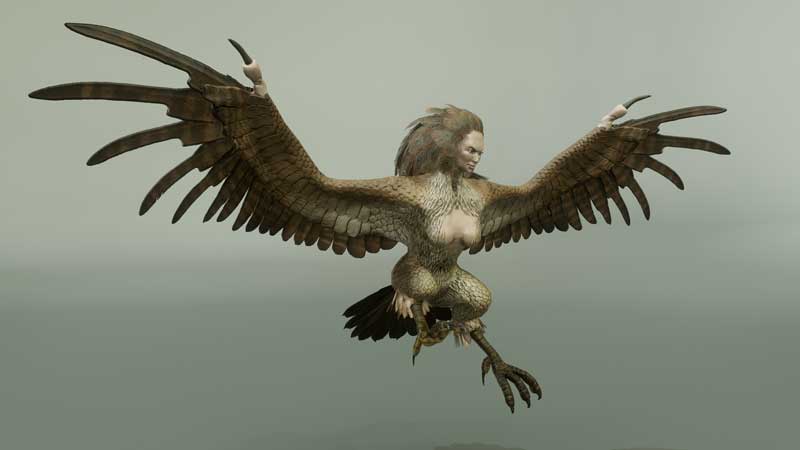
In Greek mythology, the Harpies were winged monsters with a human female face and youthful long hair, who on their swift wings keep pace with the blasts of the winds. As instruments of God, they abduct the evildoers and torture them on the way to Hades to be punished by Erinyes, the female goddesses of vengeance and retribution. The early Greek poet Hesiod described them as lovely fair locked and winger maidens, the daughters of Thaumas and the Oceanid Electra, who surpassed winds and birds in the speed of flight. But, while Aeschylus, the father of Greek tragedy, described them in his Eumenides as hideous monsters with beaks and claws, according to the Roman poet Virgil, they possessed faces haggard with hunger insatiable and talons as hands.The meaning of their name is snatchers, which is very appropriate, as they act as the hounds of Zeus to snatch away people and other things from the earth. Sudden and mysterious disappearances were often attributed to them.
However, like many other characters in Greek mythology, Harpies evolved with time. Initially, they were classified as wind spirits and the personifications of destructive winds, later personified as the winged women and eventually into the monstrous creatures, whose abode was either the islands of Strofades or a cave in Crete. Often they were depicted as the cousins of the Gorgons, the three sisters with hair made of horrible venomous snakes, who could kill people just by looking at them. While only two Herpies were mentioned by Hesiod, Aello (storm swift) and Ocypete (swift wing), the third was later added by Virgil, named Celaeno (darkness). In the Homeric poems, the Harpies are only the personified storm winds and he named only one, Podarge (felt foot), who was married to the West Wind Zephyrus and gave birth to the two horses of Achilles, Xanthus and Balius.

The Harpies played a vital role and appeared as the evil forces in Ovid’s celebrated story of King Phineus of Thrace, who was granted the gift of prophecy by Zeus. But, subsequently, the king earned the wrath of Zeus, as he used the gift against the interest of the gods by divulging their secret plans. The enraged Zeus punished the king by blinding him and banishing him on a desolate island with the availability of food.
However, the blind king could not eat anything, as the Harpies would swoop down and snatch it away before the king could satisfy his hunger. It continued for a prolonged period until Phineus was rescued by Jason, the leader of the Argonauts, while the Boreades, the twin winged brothers Calais and Zetes, sons of Boreas and Oreithyia, drove the Harpies away and chased them to the Strophades Islands, where the goddess Iris commanded them to turn back and leave the storm-spirits unharmed.

The Harpies also played a mischievous role in the mythological story of the daughters of Pandareus. As Pandareus stole a bronze dog from a temple to Zeus on Crete, he was perished by the gods, along with his wife, while their daughters, Cleodora and Merope, were spared. They were raised by the Greek goddesses on Mount Olympus and Aphrodite willingly became their guardian. Influenced by Aphrodite’s generous act, other goddesses also took pity on them. Hera gifted them beauty and wisdom, Artemis gave the lofty stature and Athena gave them the skill in handiwork. When the girls grew up to be married, Aphrodite one day went to seek permission from Zeus for their marriages and in her absence, the sisters were carried off by the Harpies, who delivered them to Erinyes to become their servants. Homer also implied that they lost their mortality in the process.
Today, the term harpy is often used metaphorically to refer to a nasty or annoying woman, while the harpy eagle is a real bird named after the mythological monster.
